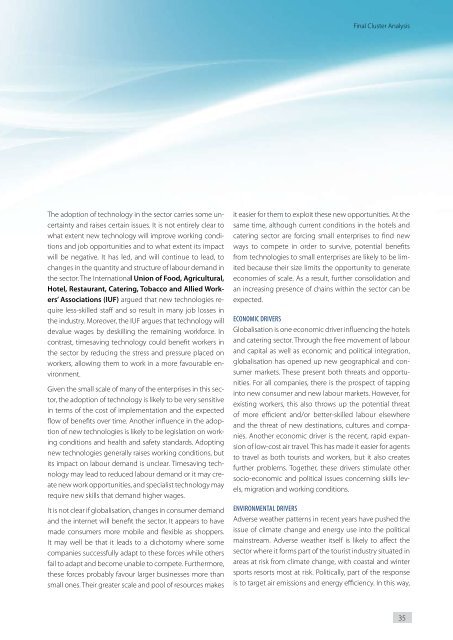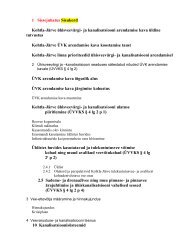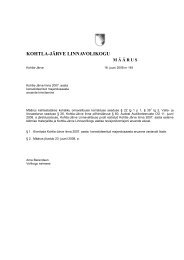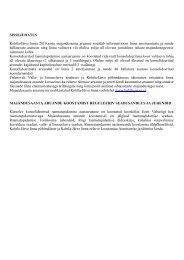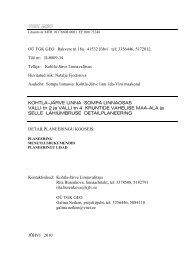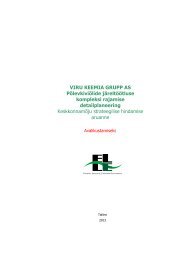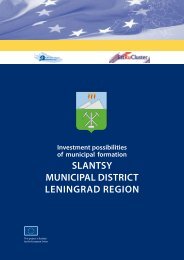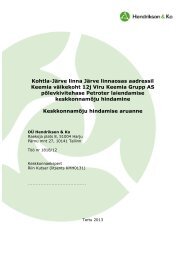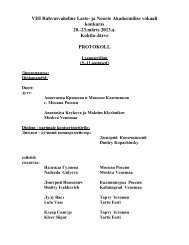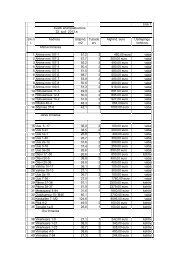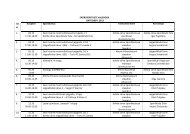FINAL CLUSTER ANALYSIS - Kohtla-Järve
FINAL CLUSTER ANALYSIS - Kohtla-Järve
FINAL CLUSTER ANALYSIS - Kohtla-Järve
You also want an ePaper? Increase the reach of your titles
YUMPU automatically turns print PDFs into web optimized ePapers that Google loves.
The adoption of technology in the sector carries some uncertainty<br />
and raises certain issues. It is not entirely clear to<br />
what extent new technology will improve working conditions<br />
and job opportunities and to what extent its impact<br />
will be negative. It has led, and will continue to lead, to<br />
changes in the quantity and structure of labour demand in<br />
the sector. The International Union of Food, Agricultural,<br />
Hotel, Restaurant, Catering, Tobacco and Allied Workers’<br />
Associations (IUF) argued that new technologies require<br />
less-skilled staff and so result in many job losses in<br />
the industry. Moreover, the IUF argues that technology will<br />
devalue wages by deskilling the remaining workforce. In<br />
contrast, timesaving technology could benefi t workers in<br />
the sector by reducing the stress and pressure placed on<br />
workers, allowing them to work in a more favourable environment.<br />
Given the small scale of many of the enterprises in this sector,<br />
the adoption of technology is likely to be very sensitive<br />
in terms of the cost of implementation and the expected<br />
fl ow of benefi ts over time. Another infl uence in the adoption<br />
of new technologies is likely to be legislation on working<br />
conditions and health and safety standards. Adopting<br />
new technologies generally raises working conditions, but<br />
its impact on labour demand is unclear. Timesaving technology<br />
may lead to reduced labour demand or it may create<br />
new work opportunities, and specialist technology may<br />
require new skills that demand higher wages.<br />
It is not clear if globalisation, changes in consumer demand<br />
and the internet will benefi t the sector. It appears to have<br />
made consumers more mobile and fl exible as shoppers.<br />
It may well be that it leads to a dichotomy where some<br />
companies successfully adapt to these forces while others<br />
fail to adapt and become unable to compete. Furthermore,<br />
these forces probably favour larger businesses more than<br />
small ones. Their greater scale and pool of resources makes<br />
Final Cluster Analysis<br />
it easier for them to exploit these new opportunities. At the<br />
same time, although current conditions in the hotels and<br />
catering sector are forcing small enterprises to fi nd new<br />
ways to compete in order to survive, potential benefi ts<br />
from technologies to small enterprises are likely to be limited<br />
because their size limits the opportunity to generate<br />
economies of scale. As a result, further consolidation and<br />
an increasing presence of chains within the sector can be<br />
expected.<br />
economIc DrIvers<br />
Globalisation is one economic driver infl uencing the hotels<br />
and catering sector. Through the free movement of labour<br />
and capital as well as economic and political integration,<br />
globalisation has opened up new geographical and consumer<br />
markets. These present both threats and opportunities.<br />
For all companies, there is the prospect of tapping<br />
into new consumer and new labour markets. However, for<br />
existing workers, this also throws up the potential threat<br />
of more effi cient and/or better-skilled labour elsewhere<br />
and the threat of new destinations, cultures and companies.<br />
Another economic driver is the recent, rapid expansion<br />
of low-cost air travel. This has made it easier for agents<br />
to travel as both tourists and workers, but it also creates<br />
further problems. Together, these drivers stimulate other<br />
socio-economic and political issues concerning skills levels,<br />
migration and working conditions.<br />
envIronmental DrIvers<br />
Adverse weather patterns in recent years have pushed the<br />
issue of climate change and energy use into the political<br />
mainstream. Adverse weather itself is likely to aff ect the<br />
sector where it forms part of the tourist industry situated in<br />
areas at risk from climate change, with coastal and winter<br />
sports resorts most at risk. Politically, part of the response<br />
is to target air emissions and energy effi ciency. In this way,<br />
35


